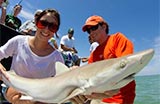Is translocation a move in the right direction for conservation policy?
by Evan Byrnes, RJ Dunlap Marine Conservation program intern
According to the International Union for Conservation of Nature guidelines, “translocation” refers to a “deliberate and mediated movement of wild individuals or populations from one part of their range to another” . However, it often is used to describe movements outside of the natural range. These “planned invasions” are used for the purpose of augmenting game populations, resolving human-wildlife conflict, and conservation. It has been used to successfully conserve species like the Hawaiian Monk Seal, and attempted for various other species such as sea otters in Southern California. Although translocation has become a somewhat popular tool for conservation, it presents extremely high risks and there is some work showing it may not be viable.
Adding or removing a species from an ecosystem can erode the biodiversity, and the ecosystem is disrupted. With biodiversity changed and fundamental process can be altered, such as nutrient cycling, primary and secondary production, and the hydrology. These impacts and their intensity can be very difficult to predict and can cause for entire ecosystems to crash. For example a North American freshwater shrimp was introduced in Flathead Lake in Montana to enhance the diet of a salmon, but due to the shrimps nocturnal nature they were inaccessible to the salmon. They resided in the dark depths in cracks in the lakebed during the day and fed at night. Instead of supplementing the salmons, diet they ultimately became the salmons’ major food competitors and caused the salmon to die of starvation . Without enough research the species ended up causing unintended problems. Such examples where native species are extirpated and food webs are disrupted are common.
While it is true that examples like the shrimp introduction could be prevented with enough careful research, it is hard to possibly predict every single effect. Some effects may be completely unpredictable though. Diseases or pests that are introduced into populations become a major problem and are rarely predicted. One example of this was when West Nile virus was introduced to into the United States and since then has caused many avian population declines. Introduced species can be introduced without showing any signs of infection due to their immunity. Once in the naïve population disease can spread like wildfire and cause mass mortalities.
With these things considered, maybe translocation is not as viable for conservation as once thought. Until there is better risk assessment it is extremely difficult to properly and safely use. The current cost-benefit analysis used can be dangerously misleading and conservation managers only have a few tools enabling them to reliably predict the worst invasion threats. The best predictor is past history of invasions, but if there are no recorded past events then a threat may be unpredictable.
The contingency of threats provided by invasions can have to do with how threats vary across time and space as well. As environments change due to climate change threats change as well. Several threats have a lag time due to factors such as evolution or climate change and cause interactions between species that are completely unexpected. Once a species is established and has caused problems, it is very difficult to eradicate. This has only successfully completed twice for marine alien species. Ultimately, translocation creates more conservation problems than it solves, and prevention remains better than cure.
Baker, J., Becker, B., Wurth, T., Johanos, T., Littnan, C., & Henderson, J. (2011). Translocation as a tool for conservation of the Hawaiian monk seal Biological Conservation, 144 (11), 2692-2701 DOI: 10.1016/j.biocon.2011.07.030
Branch, G., & Nina Steffani, C. (2004). Can we predict the effects of alien species? A case-history of the invasion of South Africa by Mytilus galloprovincialis (Lamarck) Journal of Experimental Marine Biology and Ecology, 300 (1-2), 189-215 DOI: 10.1016/j.jembe.2003.12.007
Ricciardi, A., & Simberloff, D. (2009). Assisted colonization is not a viable conservation strategy Trends in Ecology & Evolution, 24 (5), 248-253 DOI: 10.1016/j.tree.2008.12.006
Vogel, G. (2000). ENDANGERED SPECIES: Migrating Otters Push Law to the Limit Science, 289 (5483), 1271-1273 DOI: 10.1126/science.289.5483.1271a




Leave a Reply
Want to join the discussion?Feel free to contribute!